June 16, 2020
Underwater discovery prompts shakeup of long-held theories for origins of life
How did life begin? It’s a question so fundamental that it has likely been pondered by every human who has ever lived. The origin of life on ancient Earth is one of the oldest scientific mysteries. While researchers have been able to shed light on the subject over the years, the answers to sizable questions about how Earth’s first organisms came to be remain couched in theory.
An important new discovery by Dr. Benjamin Tutolo, PhD, assistant professor in the Department of Geoscience, and co-authors Nicholas Tosca at the University of Oxford and Bill Seyfried at the University of Minnesota, calls into question the leading theories behind the early days of earthly life with an unlikely catalyst — the sea sponge.
The findings, published in the Proceedings of the National Academy of Sciences, prompt a second look at hydrogen gas-dependent scenarios for the origins of life on our planet, and a re-examination of what is currently known about the composition of Earth’s ancient atmosphere.
Conditions on ancient Earth cannot be compared to today
While one of the longest-standing theories for life’s origins has suggested that deep ocean hot springs gave rise to Earth’s first lifeforms, Tutolo’s latest study shows this hypothesis is biased by our limited observations of hot springs on the modern Earth.

Carbonate growths on a ledge of the Lost City Hydrothermal Field, an area of marine alkaline hydrothermal vents located on the Atlantis Massif at the intersection between the Mid-Atlantic Ridge and the Atlantis Transform Fault, in the Atlantic Ocean.
National Science Foundation (University of Washington/Woods Hole Oceanographic Institution)
On modern Earth, underwater hydrothermal vents are pumping hydrogen gas into our oceans. The hydrogen-rich water emitting from these hot springs is a byproduct of the interaction of heated seawater with rocks from Earth’s mantle that are exposed at the ocean floor.
The other byproduct is a rock mostly made up of a group of minerals known as the serpentines. These minerals give this process its name: serpentinization. Since serpentinization also happens to bring together all of the right ingredients at the right temperatures for ancient microscopic organisms to thrive, serpentinizing systems on the seafloor are a leading candidate for the location of life’s origins.
A microscope image of serpentinized olivine, showing serpentine formation. This rock was not examined as part of the study, but exemplifies the serpentinization process.
However, Tutolo explains, “What we show in this paper is that the modern fluxes of the hydrogen coming out from these systems are probably anomalous compared to the rest of Earth’s history.”
Sea sponges catalyze changes in atmosphere composition
Our modern oceans are missing one key ingredient — dissolved silica — that make modern serpentinizing systems quite different from their ancient counterparts. Using thermodynamic calculations, the researchers show that hydrogen gas concentrations in these hot-spring fluids would have been up to 100 times lower in the silica-rich early oceans than they are today.
“Before about 800 million years ago, there was a lot more silica in sea water — 20 times as much,” Tutolo says. “There was much less hydrogen coming out of the underwater vents, so they may not have been as attractive of a place for the origin of life as they would be today.”
Silica is the backbone of nearly all rocks on earth, in the same way that carbon is the backbone of all living matter. On the ancient Earth, silica weathered out of these rocks and washed into the oceans. Around 700 million years ago, this began to change in a major way, as the first silica-skeletoned creatures — sea sponges — began to appear in Earth’s oceans and exploit this overabundance of silica to form their skeletal structures.
Eventually, so many other organisms were creating their skeletons out of silica that its concentration in today’s oceans is now around 20 times less than it was before they appeared.
“Our findings show that the abundant hydrogen gas being emitted from modern serpentinizing systems is occurring because of the dramatic decrease in silica concentration in the modern oceans,” Tutolo says.

A schematic diagram illustrating the evolution of seawater silica concentrations and hydrogen fluxes from low-temperature hydrothermal vents over geologic time.
“This discovery necessarily prompts a re-examination of our models for the composition of Earth’s ancient atmosphere, as well as a second look at hydrogen gas-dependent scenarios for the origin of life on Earth. This work can also help guide the search for life on other water-rich planetary bodies, where dissolved silica concentrations are unlikely to be limited by biological processes as they are on Earth today.”
The research was funded by the Natural Sciences and Engineering Research Council of Canada (NSERC) through a Discovery Grant to Tutolo, and the National Science Foundation through a grant to Seyfried.
An International Collaborations grant from University of Calgary International funded flights for Tutolo and Tosca to collaborate on the research.

Dr. Ben Tutolo



